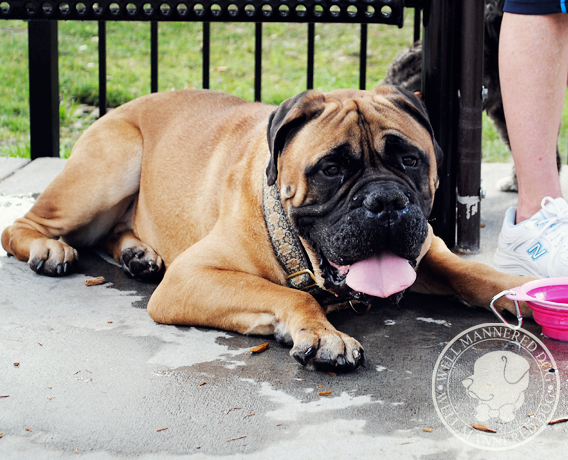
Signs of an Overheated Dog

How to tell your dog is overheated and what to do about it.
It’s that wonderful time of year again. The sun is shining, the days are warm, and outside activities are on everyone’s to do list. The Lowcountry boasts many dog friendly restaurants, parks, and beaches where you and your furry friend can enjoy a quick outing together or make a whole day of it. However, the heat can get oppressive for human and canine alike, and overheating is a real and deadly health concern for dogs. Learning the warning signs and what to do about them can save your dog’s life.
Every dog can overheat. Once a dog has done so, they are more susceptible to do it again. The short nosed brachiophelactic dogs (Pugs, bulldogs, or anything without the longer canine snout) are doubly sensitive. When a dog’s temperature begins to rise, they pant to cool themselves down. Fortunately, this exposes their tongue and gums which is first thing to keep an eye on to monitor for overheating.
LOOK
Become familiar with your dog’s normal tongue color. When your dog is panting and the color begins to darken, you know that the body is beginning to struggle with cooling. This is the time to act. Offer your pet cool water. Get to a shady spot and encourage your pet to lie down. Wetting the underside of the dogs body in the “armpits”, both front and rear can assist in cooling. Also, wetting the muzzle will help the dog. If you have a long haired or thick coated dog avoid fully saturating the whole animal at this point; concentrate on the muzzle and underside where the blood runs close to the skin.
LISTEN
Once your dog is in a shaded area and you are applying water, take a moment to listen to your dog. If the dog’s breathing rate is very rapid, it’s time to head out and find some air conditioning. If there is a “rasp” to the breathing then you could be nearing a medical emergency. Saturate the dog if possible. An alcohol based antibacterial gel can be applied to the pads of the feet to aid in cooling, or rubbing alcohol if you have it on hand. Once the dog is wet they can be placed in front of a fan if one is nearby. Do not use ice to aid in cooling; bringing the body temperature down too fast is a concern. If possible, take your dog’s temperature. Continue your cooling efforts until it reaches around 104.
TOUCH
Feel the consistency of your dog’s saliva. If it is thick or sticky then your dog is dehydrated. Dehydration can happen rapidly when fighting an overheating episode. If vomiting occurs then a vet visit is in order. Your vet can continue to cool your dog while giving it fluids. If the saliva is thick and the dog refuses fluids, again, time for the vet. Dehydration is nothing to toy with when your dog is overheating.
If all of the cooling steps have been taken and the dog is not cooling down it should be considered a life and death emergency. Get your dog to the nearest veterinary facility. Do not try to drive to your own. If it is after hours, then an emergency vet visit is warranted. Thankfully, if owners keep a vigilant eye and plenty of cool water on hand overheating can be easily remedied before it becomes serious.
PREVIOUS POST: Our Clients Say: Tracey G
NEXT POST: {{ keyword }}
© 2013 Well Mannered Dog Training Charleston, SC
TAGS: Health